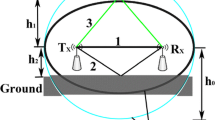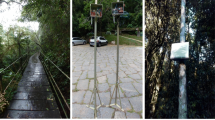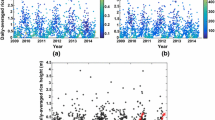Abstract
This paper presents a new propagation model for evaluating the fading of wireless communication signals in forests. The model considers rainfall and snowfall effects, and allows for the estimation of attenuation at varying frequencies in the VHF/UHF bands that are used by cognitive radios. The structure of the vegetation environment is represented here by five material layers, namely soil, scrubs and small plants under the trees, trunks of trees, foliage of trees, and free space. The model parameters are optimized using the least squares technique. The resulting model is verified by comparison with measured data where acceptable agreement is observed. The average rain rate R0.01% that will probably be exceeded for at most 0.01% of the year is computed using real measured data in Jordan. R0.01% is found to be 22.9 mm/h which agrees with the ITU recommended value of 22 mm/h.
On leave from Jordan University of Science and Technology, Irbid 22110, Jordan, salameh@just.edu.jo.
Access this chapter
Tax calculation will be finalised at checkout
Purchases are for personal use only
Similar content being viewed by others
References
FCC Report, Unlicensed operation in the TV broadcast bands, ET Docket No. 04-186, Nov 2008. https://apps.fcc.gov/edocs_public/attachmatch/FCC-08-260A1.pdf. Accessed Oct 2017
Tamir T (1967) On radio-wave propagation in forest environments. IEEE Trans Antennas Propag 15(6):806–817
Meeks ML (1983) VHF propagation over hilly, forested terrain. IEEE Trans Antennas Propag 31(3):483–489
Low K (1988) UHF measurement of seasonal field-strength variations in forests. IEEE Trans Veh Technol 37(3):121–124
Tewari RK, Swarup S, Roy MN (1990) Radio wave propagation through rain forests of India. IEEE Trans Antennas Propag 38(4):433–449
Al-Nuaimi MO, Hammoudeh AM (April 1994) Measurements and predictions of attenuation and scatter of microwave signals by trees. In: IEE proceedings—microwaves, antennas & propagation, vol 141, no 2, pp 70–76
Al Salameh MSH, Qasaymeh MM (2004) Effects of buildings and trees on satellite mobile communications. Int J Electron 91:611–623
Song Meng Y, Hui Lee Y, Chong Ng B (2009) The effects of tropical weather on radio-wave propagation over foliage channel. IEEE Trans Veh Technol 58(8):4023–4030
Song Meng Y, Hui Lee Y, Chong Ng B (2009) Empirical near ground path loss modeling in a forest at VHF and UHF bands. IEEE Trans Antennas Propag 57(5):1461–1468
Al Salameh MSH Vegetation attenuation combined with propagation models versus path loss measurements in forest areas. In: World symposium on web application and networking—international conference on network technologies and communication systems, 22–24 Mar, 2014. Hammamet, Tunisia, pp 120–124
Okamura S, Oguchi T (2010) Electromagnetic wave propagation in rain and polarization effects. In: Proceedings of the Japan academy, series B, vol 86
Sugiyama S, Enomoto H, Fujita S, Fukui K, Nakazawa F, Holmlund P (2010) Dielectric permittivity of snow measured along the route traversed in the Japanese-Swedish Antarctic expedition 2007/08. Ann Glaciol 51(55):9–15
Tamošiunaite M, Tamošiuniene M, Gruodis A, Tamošiunas S (2010) Prediction of electromagnetic wave attenuation due to water in atmosphere. 1. Attenuation due to rain. Int J Innov Info-technol Sci Bus Educ 2(9):3–10
Saunder SR, Aragon-Zavala A (2007) Antennas and propagation for wireless communication systems, 2nd edn. Wiley, Chichester, England
ITU-R recommendation P.838-3 (03/05) approved in 2005-03-08: Specific attenuation model for rain for use in prediction methods, International Telecommunication Union 2005. https://www.itu.int/rec/R-REC-P.838-3-200503-I/en
Ippolito LJ Jr (1986) Radiowave propagation in satellite communications. Springer, Heidelberg, Germany
Final Feasibility Study Report (12 147 RP 04), “Red sea—dead sea water conveyance study program,” Appendix A—climate change study, April 2011. http://www.waj.gov.jo/sites/en-us/Documents/RSDS%20Project/vol1/Appendix%20A%20-%20Climate%20Change.pdf. Accessed Sept 2017
ITU-R recommendation P.837. approved in 2012: Characteristics of precipitation for propagation modelling. https://www.itu.int/rec/R-REC-P.837/en. Accessed Sept 2017
Jordanian Meteorological Department. http://jometeo.gov.jo/. Accessed Sept 2017
Meng YS, Lee YH, Ng BC (2009) Study of propagation loss prediction in forest environment. Prog Electromagn Res B 17:117–133
Michael AO (2012) Standardization of attenuation formula for radio waves propagation through free space (LOS) communication links. Sci J Phys 2012, article id sjp-281
Al Salameh MSH (2014) Lateral ITU-R foliage and maximum attenuation models combined with relevant propagation models for forest at the VHF and UHF bands. Int J Netw Commun 1(1):16–24. http://www.ijnngt.org/jr2vl1.php?page=2
The World Bank, Climate change knowledge portal. http://sdwebx.worldbank.org/climateportal/index.cfm?page=country_historical_climate&ThisCCode=NGA. Accessed Oct 2017
Acknowledgements
The author would like to thank Jordan University of Science & Technology and the American University of Madaba for their continuous support.
Author information
Authors and Affiliations
Corresponding author
Editor information
Editors and Affiliations
Rights and permissions
Copyright information
© 2019 Springer Nature Singapore Pte Ltd.
About this paper
Cite this paper
Al Salameh, M.S.H. (2019). An Optimized Five-Layer Model with Rainfall Effects for Wireless Propagation in Forests. In: Kumar, A., Mozar, S. (eds) ICCCE 2018. ICCCE 2018. Lecture Notes in Electrical Engineering, vol 500. Springer, Singapore. https://doi.org/10.1007/978-981-13-0212-1_13
Download citation
DOI: https://doi.org/10.1007/978-981-13-0212-1_13
Published:
Publisher Name: Springer, Singapore
Print ISBN: 978-981-13-0211-4
Online ISBN: 978-981-13-0212-1
eBook Packages: EngineeringEngineering (R0)




